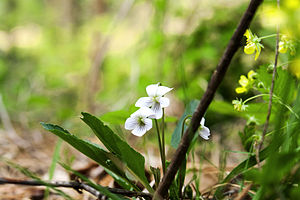Note: This is a project under development. The articles on this wiki are just being initiated and broadly incomplete. You can Help creating new pages.
Viola patrinii
Viola patrinii is a stemless, herbaceous perennial plant growing from a short, stout rhizome; it produces clusters of 3 - 5 or more basal leaves 7 - 20cm tall. The plant is harvested from the wild for local use as a food and a medicine. The dried herb is traded for medicinal purposes in local markets and exported from China to other Chinese communities around the world.
Uses
Parts Used
Chemical Composition
It contains Two isoflavonoids, tectorigenin-7-O-β-D-glucoside and luteolin-7-O-β-D-glucurono pyranoside were isolated from ethyl acetate fraction of Viola patrinii fermentation extracts.[2]
Common names
| Language | Common name |
|---|---|
| Kannada | |
| Hindi | |
| Malayalam | |
| Tamil | |
| Telugu | |
| Marathi | |
| Gujarathi | |
| Punjabi | |
| Kashmiri | |
| Sanskrit | |
| English |
Properties
Reference: Dravya - Substance, Rasa - Taste, Guna - Qualities, Veerya - Potency, Vipaka - Post-digesion effect, Karma - Pharmacological activity, Prabhava - Therepeutics.
Dravya
Rasa
Guna
Veerya
Vipaka
Karma
Prabhava
Habit
Identification
Leaf
| Kind | Shape | Feature |
|---|---|---|
Flower
| Type | Size | Color and composition | Stamen | More information |
|---|---|---|---|---|
| {{{5}}} |
Fruit
| Type | Size | Mass | Appearance | Seeds | More information |
|---|---|---|---|---|---|
Other features
List of Ayurvedic medicine in which the herb is used
Where to get the saplings
Mode of Propagation
How to plant/cultivate
Prefers a cool moist well-drained humus-rich soil in partial or dappled shade and protection from scorching winds. Tolerates sandstone and limestone soils but becomes chlorotic if the pH is too high. Prefers a pH between 6 and 6.5.[4]
Commonly seen growing in areas
Photo Gallery
References
- ↑ Indian Medicinal Plants by C.P.Khare
- ↑ Chemical constituents
- ↑ [Morphology]
- ↑ Cultivation
External Links
- Ayurvedic Herbs known to be helpful to treat Cancer
- Ayurvedic Herbs known to be helpful to treat Abscesses
- Ayurvedic Herbs known to be helpful to treat Inflammations
- Ayurvedic Herbs known to be helpful to treat Ulcers
- Herbs with Young leaves used in medicine
- Herbs with Flower buds used in medicine
- Habit - Perennial
- Index of Plants which can be propagated by Seeds
- Herbs that are commonly seen in the region of Marshy meadows
- Herbs that are commonly seen in the region of Moist places along riversides
- Herbs that are commonly seen in the region of Thickets
- Herbs that are commonly seen in the region of Shaded places at forest margins
- Herbs



